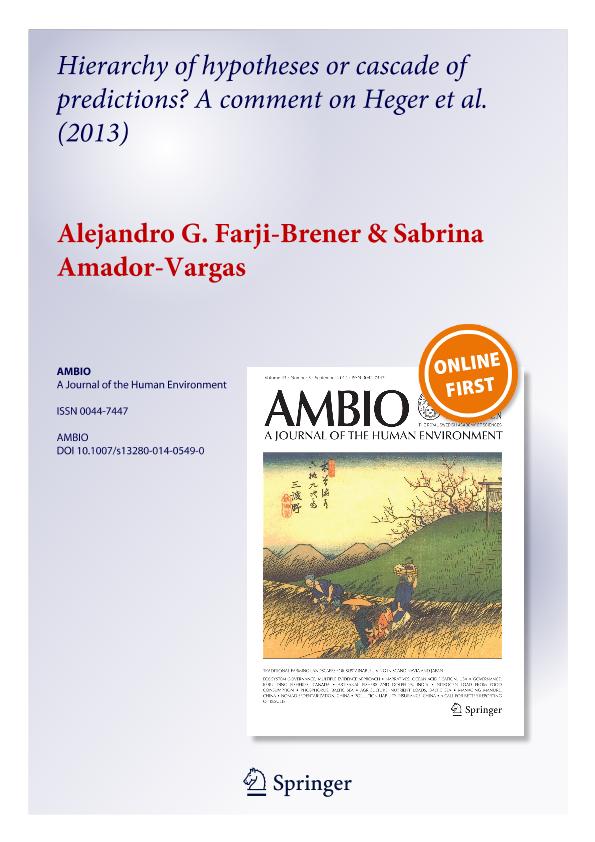Mostrar el registro sencillo del ítem
dc.contributor.author
Farji Brener, Alejandro Gustavo

dc.contributor.author
Amador Vargas, Sabrina
dc.date.available
2017-01-23T20:55:05Z
dc.date.issued
2014-12
dc.identifier.citation
Farji Brener, Alejandro Gustavo; Amador Vargas, Sabrina; Hierarchy of hypotheses or cascade of predictions? A comment on Heger et al. (2013); Royal Swedish Acad Sciences; Ambio; 43; 8; 12-2014; 1112-1114
dc.identifier.issn
0044-7447
dc.identifier.uri
http://hdl.handle.net/11336/11733
dc.description.abstract
The only way to test hypotheses is by evaluating their consequences. Since a hypothesis is an explanation of how nature works, it can be tested through the formulation of outcomes expected assuming the proposed hypothesis is true, and contrasting those predictions with the obtained results. Therefore, hypothesis and predictions are intrinsically different concepts. Hypotheses are ideas; predictions are expected results. Predictions are deduced from hypotheses, but it is unlikely to deduce a hypothesis from a prediction. Regardless of these conceptual differences, ecologists often formulate predictions but erroneously state them as hypothesis (Farji-Brener 2003). We believe that this is the case in the work of Heger et al. (2013). Here, we point out the confusion between hypotheses and predictions, highlight the importance of an adequate use of these terms, and propose the hierarchy-of-expected outcomes approach as an alternative to the hierarchy-of-hypotheses approach.
dc.format
application/pdf
dc.language.iso
eng
dc.publisher
Royal Swedish Acad Sciences

dc.rights
info:eu-repo/semantics/openAccess
dc.rights.uri
https://creativecommons.org/licenses/by-nc-sa/2.5/ar/
dc.subject
Hypothesis
dc.subject
Hiothetic-Inductive Method
dc.subject.classification
Ecología

dc.subject.classification
Ciencias Biológicas

dc.subject.classification
CIENCIAS NATURALES Y EXACTAS

dc.title
Hierarchy of hypotheses or cascade of predictions? A comment on Heger et al. (2013)
dc.type
info:eu-repo/semantics/article
dc.type
info:ar-repo/semantics/artículo
dc.type
info:eu-repo/semantics/publishedVersion
dc.date.updated
2016-12-12T14:20:27Z
dc.journal.volume
43
dc.journal.number
8
dc.journal.pagination
1112-1114
dc.journal.pais
Suecia

dc.journal.ciudad
Estocolmo
dc.description.fil
Fil: Farji Brener, Alejandro Gustavo. Consejo Nacional de Investigaciones Científicas y Técnicas. Centro Científico Tecnológico Patagonia Norte. Instituto de Investigación en Biodiversidad y Medioambiente; Argentina. Universidad Nacional del Comahue. Centro Regional Universitario Bariloche. Laboratorio de Ecotono; Argentina
dc.description.fil
Fil: Amador Vargas, Sabrina. University of Texas at Austin; Estados Unidos
dc.journal.title
Ambio

dc.relation.alternativeid
info:eu-repo/semantics/altIdentifier/url/https://www.ncbi.nlm.nih.gov/pmc/articles/PMC4235899/
dc.relation.alternativeid
info:eu-repo/semantics/altIdentifier/url/http://link.springer.com/article/10.1007%2Fs13280-014-0549-0
dc.relation.alternativeid
info:eu-repo/semantics/altIdentifier/doi/http://dx.doi.org/10.1007/s13280-014-0549-0
Archivos asociados
